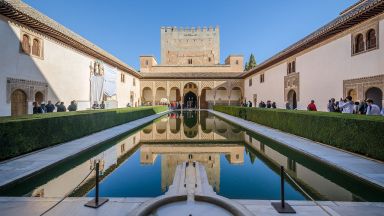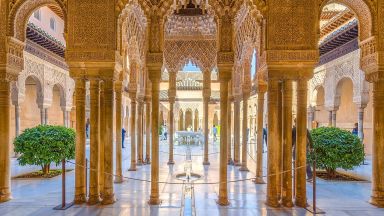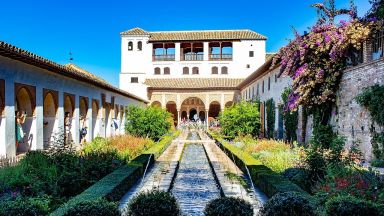Palacio de Dar-Al-Horra
Palace in Granada
The Palacio de Dar-Al-Horra or Palace of the Honest Woman is a palace situated in the Albaicín district of Granada. The 15th century palace was the residence of the sultana Aixa; who was the mother of the last Moorish sultan, Boabdil of Granada.
The History of Palacio de Dar-Al-Horra in under a minute!
The palace was originally built for a Ziri noble in the eleventh century. It is thought it could have formed part of the large palace of Zirid King Badis. in the 15th century a new palace was built upon the remains of the previous one by Sultan Muley Hassan. The Sultan Muley Hassan wanted to ease tension in his household so he removed his first wife Aixa from the Alhambra, to allow room for his new wife Isabel de Solis. Isabel was a former Christian slave, who had converted to Islam, chnged her name to Soraya or ‘the morning star’ and became the king’s favorite. This triggered jealousies and intrigues which eventually led to the fall of the king, following the rebellion of Boabdil, the son of Muley Hassan and Aixa. After the reconquest by the catholic Monarch in 1492, the palace was given to Don Hernando de Zafra.
In 1493 various agreements were signed in Dar al-Horra with the Mudejar nobility of Granada, convincing them go to Morocco with their deposed Emir.
Zafra tied to establish a convent of Dominican nuns in this building and adjacent buildings, although he did not succeed, it eventually being converted into a Franciscan convent by Queen Isabel, inhabited from 1507 to this day by nuns of the order of St Clare.
In the 20th century it was purchased by the state, thanks to the intervention of Torres Balbás who wanted to preserve the Nasrid monuments and restore the palace.
What is the Palacio de Dar-Al-Horra feel like?
It is one of the last Naziri buildings from the Moorish period. It’s surprisingly intimate, with rooms set around a central courtyard and fabulous views across the surrounding neighborhood and over to the Alhambra. The atmospheric inner garden with pool and the religious inscriptions carved in plaster work are notable characteristics of the palace. Due to being a cloistered monastery, it has maintained its former Islamic forms and part of its former Nasrid decoration intact.
After the Alhambra palace, the Palacio de Dar-Al-Horra is the most beautiful example in Granada of Moorish art with its beautiful architecture and decor. It is perhaps one of the less famous attractions in Granada, but certainly no less interesting.
What does the Palacio de Dar-Al-Horra look like?
Like in all Nasrid constructions, the whole building is arranged around a central patio and in the eastern and western sides there are different rooms, and there are porticos in the rest.
The northern portico has three horseshoe arches resting on columns and covered by a flat wood ceiling, decorated with geometrical figures. You can access a room through a horseshoe arch with a viewing point in the middle, and bedrooms on both sides, covered by alfarjes, and separated by arches. The ceilings are also made of flat wood. The viewing point have inscriptions carved into the plaster which enhance the private nature of the house with words and phrases of celebration such as “Blessing”, “Happiness”, “Health is perpetual” and “Joy continues”.
On the other side of the patio, there is a Christian chapel, with a beautiful wooden ceiling.
Its small garden is irrigated with water from the Aynadanar canal, from the large Aljibe del Rey cistern, located nearby, reaching it through the so-called Arch of the Nuns. The current public park, called Huerto de Carlos, was part of the convent garden until the nineteenth century expropriations.
Tours in and around the Palacio de Dar-Al-Horra
If you were wondering which tickets and tours are the best ones to explore the in and around the Palacio de Dar-Al-Horra? Check out these popular options:
Where does Palacio de Dar-Al-Horra get its name?
‘Dar Al-Horra’ means ‘Home of the Honest’ or the ‘House of the Honest Lady’. It was so-named for having been the official residence of Aixa la-Horra, wife of Muley Hacén and mother of the last Emir of Granada, Boabdil. In the days of the Zirí king Badis it was known as the Palacio del Gallo del Viento, due to a a odd looking weather vane of a cookeral with a horse’s head, mounted by a knight armed who was armed with lance and buckler. It is said that when the wind changes, the direction of the knight also changes, and points to the Christian enemy. This is according to the chronicles of Ibn Al-Jatib, and a story writeen by Washington Irving.
How do you get to the Palacio de Dar-Al-Horra?
The palace is located on the heights of the old Alcazaba, in the upper part of the Albaicín district and from its tower one has a magnificent view of the surroundings. It is discretely hidden in a narrow alleyway Callejón Ladrón del Agua.
The Palacio de Dar-Al-Horra appears in our Complete Guide to Visiting Granada!
This website uses affiliate links which may earn a commission at no additional cost to you!
Visiting Palacio de Dar-Al-Horra
€5, Sun free
Nearby Attractions
- Albaycin (0.2) km
Area in Granada - Plaza Larga (0.2) km
Market and Square in Granada - Mirador de San Nicolás (0.3) km
Viewing Point in Granada - Church Of San Salvador (0.4) km
Church in Granada - Arab Baths of Granada (0.4) km
Baths in Granada - Puerta de los Tablero (0.5) km
Bridge, City Gate and City Walls in Granada - Torre de los Hidalgos (0.6) km
Tower in Granada - Puerta de las Armas (0.6) km
City Gate in Granada - Torre de las Armas (0.6) km
Tower in Granada - Torre de la Vela (0.6) km
Tower in Granada



